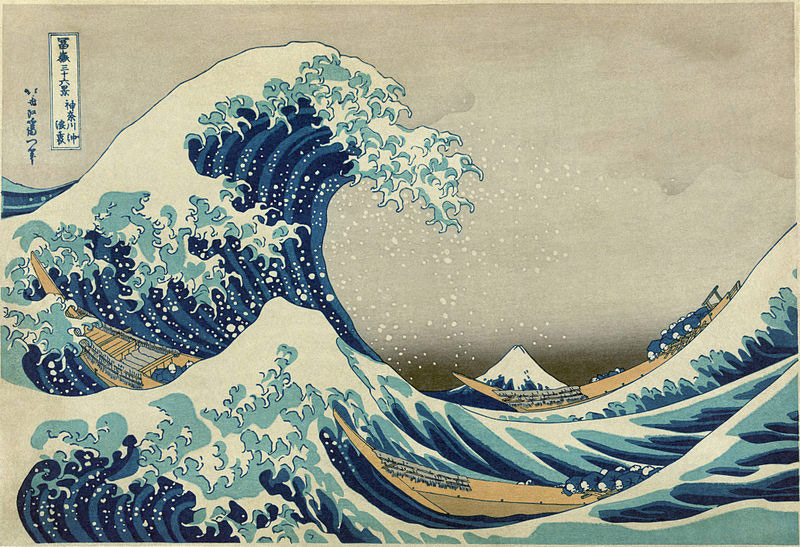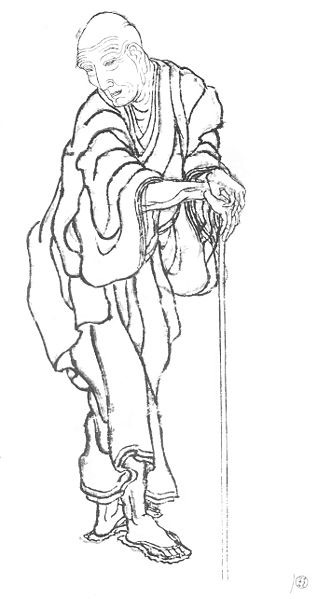Katsushika Hokusai (1760-1849) was a well-known Japanese artist. Originally born Tokitarō to a prominent mirror-maker in the Katsushika district of Edo, Japan. Katsushika Hokusai is thought to have learned art from his father. He began painting around the age of 6, and by the time he was 12 he was sent to work in a library and bookshop where many of the middle and upper class would go to appreciate wood block art and read stories. At the age of 14, he was taken in as an apprentice to learn the art of wood carving. When he was 18, he was accepted into the studio of Katsukawa Shunshō to learn the art of wood block prints.
Early Career
From his early beginnings as a student of Katsukawa Shunshō, Katsushika Hokusai began to master the art of Ukiyo-e, the Japanese art of wood block prints. These prints commonly depicted famous players in theater and popular landscapes. It was then he was given a new name, the first of his name changes of his artistic career. During this time as an apprentice he also married for the first time. Very little information is known about his first wife except that she died in the early 1790s.
When Katsukawa Shunshō died in 1793, Katsushika Hokusai began experimenting with different kinds of art popular in Europe during that time. This form of art is later what led to his fame, but also got him expelled from the studio of Katsukawa Shunshō from his chief disciple. The images of his artwork had changed from that of popular courtesans and actors to daily life of the Japanese people and common Japanese images and landscapes. His medium changed to brush paintings instead of wood blocks, and thus beginning the height of his career, as well as another name change.
Increased Fame
 Over the next decade, Hokusai gained increasing fame both because of his skill as an artist as well as his knack for self-promotion. It was said that he created a portrait of a Buddhist monk for a Tokyo festival which was over 600 feet long using brooms and buckets of ink. He was also placed in the court of the Shogun Iyenari for a competition with another local artist at the time where he was said to have won. In the court of the Shogun, he was able to learn the art of other types of brushstrokes and attract other students of art to learn his techniques. He was also paired with a writer during this period to create illustrated books. This form of art in the illustrated books has evolved into what we know now as the types of caricatures used in comic books today.
Over the next decade, Hokusai gained increasing fame both because of his skill as an artist as well as his knack for self-promotion. It was said that he created a portrait of a Buddhist monk for a Tokyo festival which was over 600 feet long using brooms and buckets of ink. He was also placed in the court of the Shogun Iyenari for a competition with another local artist at the time where he was said to have won. In the court of the Shogun, he was able to learn the art of other types of brushstrokes and attract other students of art to learn his techniques. He was also paired with a writer during this period to create illustrated books. This form of art in the illustrated books has evolved into what we know now as the types of caricatures used in comic books today.
While Hokusai contributed to the art of comic books, he is most popularly known for his ukiyo-e print series 36 views of Mt. Fuji, originally released with 36 prints. Ten more were added after original publication. 36 views of Mt. Fuji is actually 46 prints. This publication was followed by 100 views of Mt. Fuji, which is deemed as the masterpiece of his career. His landscape picture books are deemed masterpieces among many as they turned the focus of artwork at the time from courtesans and popular actors to landscapes detailing plants, people, animals, and mountains.
Precursors of Comics and Manga
Between 1814 and 1820, 12 collections of books put together known as manga were considered the precursors to today’s modern manga, the main inspiration behind comic book drawing. While these works of art were considered noteworthy in Japan during that era, he didn’t gain notoriety overseas until long after his death.
The Great Wave off Kanagawa
 The inspiration for Katsushika Hokusai’s artwork and depictions of Mt. Fuji stemmed greatly from his religious beliefs. As a member of a certain sect of Buddhism, which placed a great deal of emphasis on eternal life for which Mt. Fuji was a frequent symbol, he used his faith as inspiration. It is said that Hokusai’s obsession with Mt. Fuji draws upon the symbolism instilled by it–that of immortality and eternal life. It is his perception of the view of Mt. Fuji and his portrayal of the mountain which got the attention of art enthusiasts. In his portrayal of 36 images of Mt. Fuji, one of the most revered is the view of the mountain through a curling wave. This particular picture is named The Great Wave off Kanagawa. The wave actually appears to have lifelike quality with malicious intent, it’s frothy fingers reaching out to claim the lives of fisherman at sea. Within the curl of the wave, you can see fishermen in boats trying to stay afloat without being capsized. Mt. Fuji is in the background as just a small image centered within the curl of the wave on one side, and a boat precariously close to being tossed over on the other side.
The inspiration for Katsushika Hokusai’s artwork and depictions of Mt. Fuji stemmed greatly from his religious beliefs. As a member of a certain sect of Buddhism, which placed a great deal of emphasis on eternal life for which Mt. Fuji was a frequent symbol, he used his faith as inspiration. It is said that Hokusai’s obsession with Mt. Fuji draws upon the symbolism instilled by it–that of immortality and eternal life. It is his perception of the view of Mt. Fuji and his portrayal of the mountain which got the attention of art enthusiasts. In his portrayal of 36 images of Mt. Fuji, one of the most revered is the view of the mountain through a curling wave. This particular picture is named The Great Wave off Kanagawa. The wave actually appears to have lifelike quality with malicious intent, it’s frothy fingers reaching out to claim the lives of fisherman at sea. Within the curl of the wave, you can see fishermen in boats trying to stay afloat without being capsized. Mt. Fuji is in the background as just a small image centered within the curl of the wave on one side, and a boat precariously close to being tossed over on the other side.
Katsushika Hokusai had a self-described mania about depicting things he saw in daily life. He was restless and therefore constantly sketched what he saw. Whether it was people, places, or landscapes, Hokusai developed a style unique to himself at the time. He made his own path in his style of ukiyo-e, away from the common depictions of famous actors, courtesans and idealistic scenery. Instead he began to depict real life and real landscapes using his religious beliefs and his own artistic abilities as a medium in his artwork.
Hokusai’s Death
In 1839, within a year of Hokusai’s death, a great fire destroyed his studio, and with it many of his life’s works. At this point in his career, his popularity had already begun to wane as he was replaced with other budding artists with different styles. He still continued to paint and improve in his craft until his death. He was quoted on his deathbed saying that if heaven would just give him ten more years, even just five more years, then perhaps he could become a real painter. He died on May 18, 1849, and was laid to rest in his native city of Tokyo.
